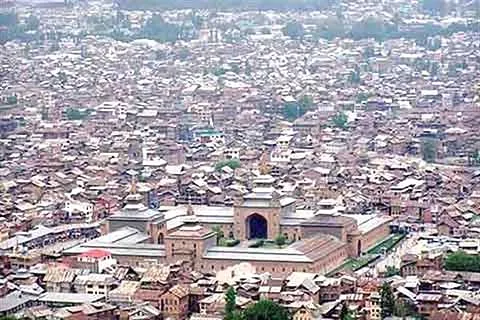The forthcoming lines aim not to pen down the history of the to-be-reconstructed Sharda Mandir devoted to the goddess Sawitri Ji located in POK but to manifest to our youths the wounded soul of our Kashmiri ethos fostered by our saints and saintesses together for centuries. Sharda Mandir is not an abandoned broken structure built out of bricks and clay only but a wound in our cultural creed bleeding silently there on the banks of Kishan Ganga and screaming together with its waters. Sharda Mandir is a yowl asking to rejoin split parts of Kashmir and the shattered ethos, the Kashmiriyat.
In the abandonment of Sharda Mandir, a person with human sensibility can see the political idiocy that led to the centuries-old Ganga-Jumani culture asunder and witness the barbarism inflicted upon the people of Kashmir in 1947. No doubt seventy years have lapsed down the lane of time, but the Mandir and the Masjid in the subcontinent are still wailing over the political blunder and misfortune that transpired. The goddess of Sharda Mandir is a witness that Kashmir suffered and still suffering the most from the narrow political vision espoused seventy tears ago.
The generations that sprouted during the last thirty years of political upheaval in Kashmir are incognizant of the plurality of Kashmiri society. The pluralism of Kashmiri society was unique and singular of its kind embedded in the soil of Rishiyat: a practical philosophy of universal brotherhood. The Rishiyat, whose political connotation is Kashmiriyat, is a society where a section is a direction towards the way of belief systems established to purify the mind but not a symbol of divergence. In the Rishi society of Kashmir, you are just a human being to the fellow next to you. Neither Sikh nor Pandith nor a Muslim, you are, but a human fellow. Rishi culture or society offers respect for being a human fellow and wholeheartedly accepts your faith.
Your worship place: Gurudawara, Mandir or Masjid, is respected by people belonging to Kashmiriyat, reflecting on them all as Asthan, a place of spirituality. Since the word spirituality corresponds to purification, thus Kashmiriyat refers to the people of purity. Albeit, Kashmiriyat is a word coined by political pundits to address conflict, still, to the people of cultural understanding of Kashmir, it is a literal reference reflecting on the rishi culture of Kashmir, believing that humanity flourishes in communion, not in confrontation. It is why in the Kashmiri rishi culture, one sees Mandir and Masjid erected side by side in most places in Kashmir. It exhibits the moral attitude nurtured by the people of Kashmir. It manifests that Kashmiriyat is an ethos of brotherhood no matter to which faith one belongs.
The following poetic verses of Kashmiri saints are enough to acknowledge that Kashmiriyat is the ethos in which religion is the spiritual journey through the Shivaism of Lala Aiswariya or the Islam of Shaik Noor u Din. It is not political structuring where people seek out their worldly gains. It is about living with one another in complete harmony regardless of religion or faith.
A great Muslim saint, Shaikh Noor-u-Din aka Shaikh Aalamdar Kashmir, a Muslim religious personality, the most revered and loved by Muslims and Pandits alike, has paid homage to Lala Aishwariya, a Shivite saintess, in the verses as:
‘‘ That Lala of the village of the Lotuses,
Savoured elixir of life to her full;
She, our saint, bore God in her bosom,
O God! Endow me with such merits.’’
How can a Kashmiri Muslim harass another Kashmiri fellow who follows the Shivaism of Lala Aarifa when he knows his Master, whom he loves and respects, is a great admirer of the Shivite saintess?
Another towering Rishi and poet of the Rishi society of Kashmir, Hz Shamus Fakir, does glorify the Saintess and Aarifa, Lala Aishwariya, in his non-immutable verses:
As Lalla combined her soul with the skies,
Keep your knowledge focused on God;
Lalla ran to the river for a bath,
She Knew how to cross the river of Life;
Had Muslims and Pandits been antipathetic to one another, how could Pandiths visit Shrines of Sheikh. Alamdar, Sk. Maqdoom and ten’s of Muslim Saint Shrines? The fact is that Rishism or Sufism is a common thread binding both Pandits and Muslims in the culture of Kashmiriyat. Muslims remember Lala Aishwariya as Lala Aarifa (A woman of deep spiritual insight).
She is the saintess greatly respected and loved by Muslims of the Rishi society of Kashmir. Besides respecting and admiring Sheikh Alamdar and Sheikh Maqdoom, the Pandit people of the Rishi society of Kashmir offer great reverence to Sheikh Abdul Qadir Jeelani of Baghdad. They remember them as Kah-Noove (The saint who has 11 names). Even they swear in his name as ‘‘Kah-Naaves Patt!’’
Thus Kashmiriyat is not a political idea to mend the ‘‘fissures’’ but a spiritual ethos profoundly rooted in the Rishi or Sufi culture of Kashmir.
We see the reconstruction of Sharda Mandir as an appreciable move towards mending Kashmiri Ethos, Kashmiriyat, which unfortunately met a repulsive blow in the last three decades due to some narrow-minded political people of Kashmir and Pakistan’s antipathy.
Disclaimer: The views and opinions expressed in this article are the personal opinions of the author.
The facts, analysis, assumptions and perspective appearing in the article do not reflect the views of GK.







